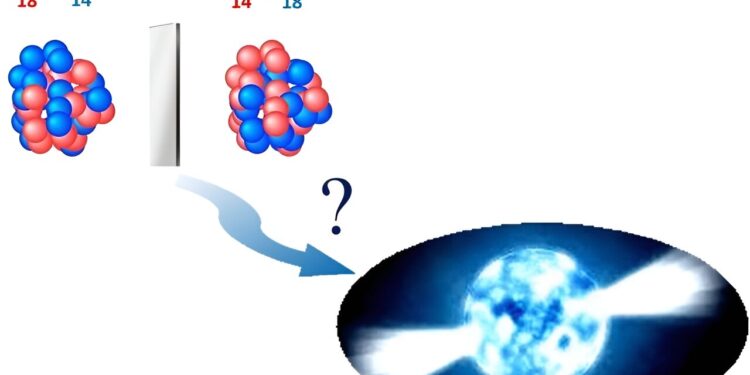Differences in charge radii in mirror nuclei, which have opposite numbers of protons and neutrons, can help constrain the parameters of the equation of state for nuclear matter, which describes the properties of astrophysical objects such as neutron stars. Credit: Ronald Garcia/Dean Lee
Adding or removing neutrons from an atomic nucleus causes changes in the size of the nucleus. This in turn causes tiny changes in the energy levels of the atom’s electrons, called isotope shifts. Scientists can use precise measurements of these energy shifts to measure the radius of an isotope’s nucleus.
In a recent study, researchers made laser-assisted measurements of the nuclear radii of the stable silicon isotopes silicon-28, silicon-29, and silicon-30. They also measured the radius of the unstable nucleus silicon-32, which has 14 protons and 18 neutrons. The researchers used the difference between the radius of the silicon-32 nucleus and that of its mirror nucleus, argon-32, which has 18 protons and 14 neutrons, to set limits on variables that help describe the physics of astrophysical objects such as neutron stars. These results are an important step in the development of nuclear theory, the study of nuclei and their components.
The article is published in the journal Physical Exam Letters.
Despite advances in nuclear theory, scientists still face long-standing challenges in their understanding of nuclei. For example, researchers have failed to connect the description of the size of the nucleus to the underlying theory of the strong nuclear force. Furthermore, it is uncertain whether nuclear theories that describe finite atomic nuclei can provide a reliable description of nuclear matter. This special form of matter consists of interacting protons and neutrons. Nuclear matter includes matter in extreme conditions such as neutron stars. Precise measurements of charge radii (the radius of atomic nuclei) help resolve these open questions.
Researchers used atomic isotope shift laser spectroscopy measurements to measure the nuclear radii of different silicon isotopes at the Beam Cooling and Laser Spectroscopy Facility (BECOLA) of the Facility for Rare Isotope Beams (FRIB) at Michigan State University.
The results obtained constitute an important reference for the development of nuclear theory. The difference in charge radius between the silicon-32 core and its mirror argon-32 core was used to constrain the parameters necessary for the description of the properties of dense neutron matter within neutron stars. The results obtained are consistent with the constraints of gravitational wave observations and other complementary observables.
More information:
Kristian König et al., Nuclear charge radii of silicon isotopes, Physical Exam Letters (2024). DOI: 10.1103/PhysRevLett.132.162502. On arXiv: DOI: 10.48550/arxiv.2309.02037
Provided by the U.S. Department of Energy
Quote:’Mirror’ cores help connect nuclear theory and neutron stars (2024, August 13) retrieved August 14, 2024, from
This document is subject to copyright. Apart from any fair dealing for the purpose of private study or research, no part may be reproduced without written permission. The content is provided for informational purposes only.



